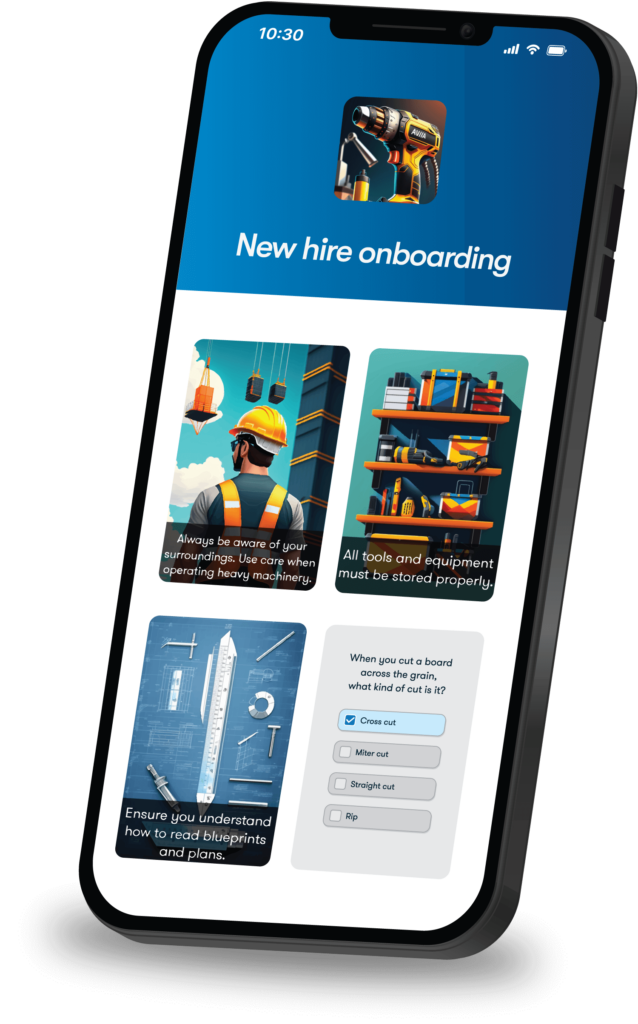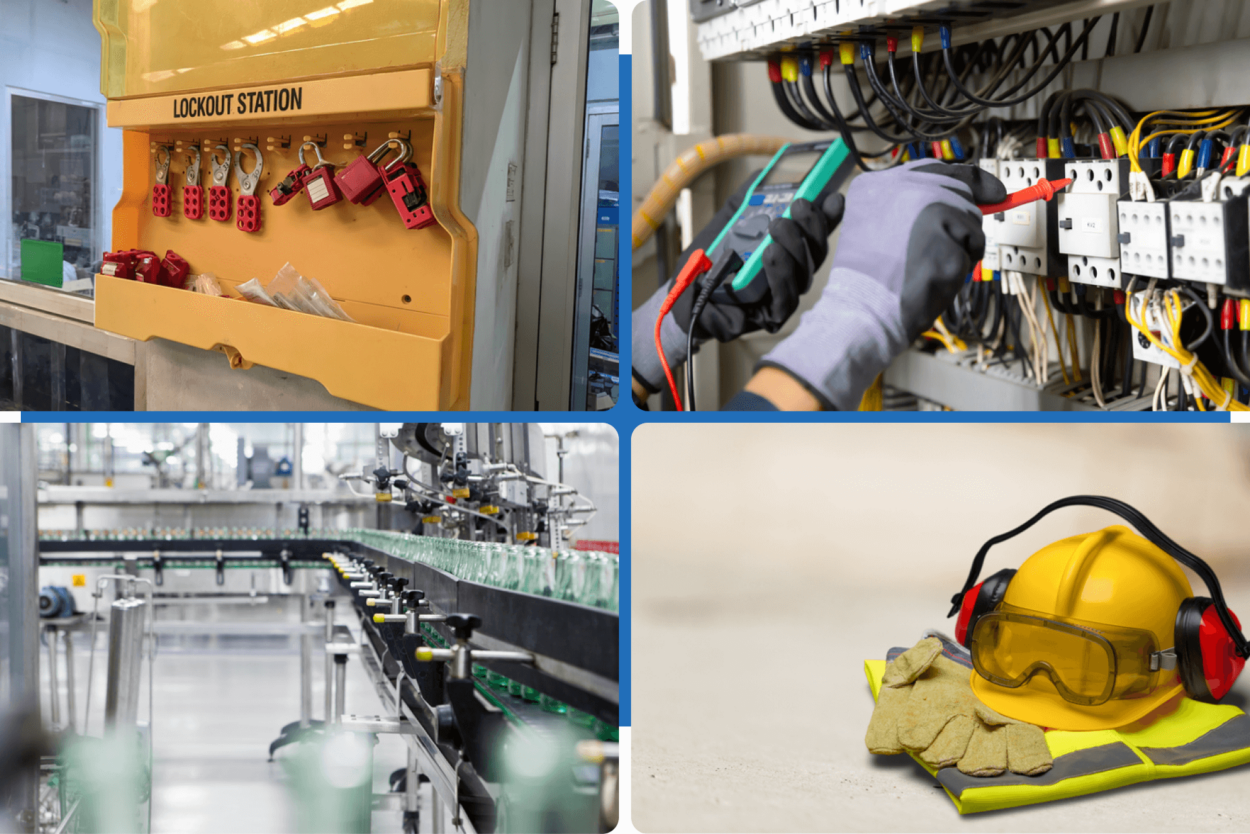In 2019, private industry employers recorded 2.8 million nonfatal workplace injuries and illnesses. The manufacturing industry accounted for 15% of these incidents. These statistics highlight the importance of prioritizing safety topics in manufacturing to ensure the well-being of your staff.
Keeping your employees safe is the top priority for overall workplace safety. It’s also critically important that you protect your business by remaining compliant with regulations, and minimizing workers’ compensation expenses. This is why it’s important to consider which manufacturing safety topics will lead to meaningful training and protecting your employees and business.
What are some good safety topics for work? Follow along for 11 impactful topics that will help get you started.
What is a manufacturing safety meeting?
A manufacturing safety meeting is a time for employees to discuss and review safety topics relevant to their work setting. These meetings are vital components of a strong safety program. They play a key role in preventing accidents, minimizing injuries, and avoiding illnesses among the workforce. Manufacturing safety meetings work alongside safety protocols, training, audits, incident response, and recordkeeping.
Distinguished from succinct toolbox talks, safety meetings are characterized by their formality, duration, and expansive scope. Typically spanning 20 to 45 minutes, these sessions can occur as presentations, interactive activities, or group discussions. Choosing the right format allows for in-depth exploration of critical safety topics.
The primary goal of a manufacturing safety meeting is to ensure that all team members fully understand safety topics. By creating an environment where everyone comprehends safety protocols and actively applies preventive measures, these meetings are pivotal in establishing a safer and more secure workplace for everyone involved.
11 impactful manufacturing safety topics for your next meeting
1. Machine safeguards
The day-to-day use of machines can make it easy to forget about their hazards. Using machines without safeguards can lead to injuries. Machine safeguards add an extra layer of safety while on the job.
Some hazards include:
- Moving parts like belts, gears, chains, and rollers
- Electrical charges and energized components
- Pinch points
- Surfaces with extreme temperatures
- Open flames
There’s a large variety between machinery, with each requiring specific guards for safety purposes.
The most frequently used guards are:
- Substitution or elimination
- Personal protective equipment (PPE)
- Awareness method
- Engineering controls
- Procedural methods
You must conduct a risk assessment on each machine to determine when to use the appropriate guards. Once the machine safeguard is decided on, have regular safety meetings to review procedures.
2. Lockout/Tagout procedures
Lockout/Tagout (LOTO) training is one of the most important safety topics for the manufacturing industry. LOTO is the procedure of controlling hazardous energy during maintenance, inspections, and repairs. When energy isn’t controlled properly, it can lead to injury or even death.
Important LOTO points to remember:
- Train and review procedures often with authorized employees (those placing the locks and tags).
- Train and review procedures often with the affected employees (those who use the machines that are worked on).
- Review shift change procedures when LOTO takes place.
- Follow all local, state, and federal guidelines.
3. Hazard communication
In 1983, OSHA implemented The Hazard Communication Standard. OSHA put it in place to protect employees from dangerous hazards in the workplace. Having thorough hazard communication is not only required, but creates a healthier workplace.
Here are some ways that your staff might experience hazards:
- Inhalation
- Ingestion
- Absorption through skin
- Injection (sharp object or through a break in the skin)
In 2012, the United States implemented The Globally Harmonized System. Simply put, this made it much easier for employees to comprehend safety data sheets and labels. Take an active role in knowing what hazards are in your workplace and keep this factory safety topic top of mind.
4. Respiratory protection
More than 5 million people use respirators at work in the United States each year. A high risk is involved with this massive number of respirators used on the job. This is why OSHA requires annual respiratory protection training, keeping it a top safety topic for the manufacturing industry.
Respiratory hazards are diverse and can range from:
- Gasses
- Vapors
- Dust
- Infectious agents
- Chemical hazards
These hazards can cause immediate health concerns, such as carbon monoxide poisoning, or have long-term effects, like asbestos-related lung cancer, developing after long-term exposure.
5. Wiring and electrical safety
Electrical hazards present substantial risks in work settings, often leading to the potential danger of electrocution. Employees working with or near electrical equipment are especially at risk of these hazards. Wiring, commonly associated with electrical risks, poses challenges due to its extensive presence and susceptibility to damage. Recognizing these hazards is critical for workplace safety and should be a key topic in your plant safety meetings.
Types of electrical hazards:
- Torn, frayed, or exposed wires
- Overcrowded or tangled wiring
- Loose electrical connections and substandard insulation
- Malfunctioning equipment and improper use of cords
- Grounding issues and broken connections
- Incorrect usage of flexible cords, especially in industrial settings
- Misplacement of wires near conductive substances or sharp edges
- Improper use of temporary wiring for permanent fixtures
- Lack of proper guarding for exposed live parts
- Issues related to ungrounded or uninsulated equipment
- Lockout/tagout procedure deficiencies and inadequate training in electrical safety
Wiring and electrical safety are important for your staff’s well-being. It can also bring major fines when done improperly, with OSHA penalties exceeding $15,000 per violation.
6. Personal Protective Equipment (PPE)
Personal Protective Equipment (PPE) is a barrier between your staff and potential harm at work. Making sure everyone uses this gear and uses it properly is critical.
Some common production safety topics for PPE:
- Identifying the right PPE for different tasks
- Proper techniques for wearing PPE
- Maintaining and storing PPE correctly
- Recognizing issues with PPE and knowing how to report them
- Complying with PPE usage for workplace safety
Just having the gear isn’t enough. Your staff needs to understand what each piece of PPE is for, how to use it correctly, and what to do if it fails.
7. Fall protection
According to OSHA, more than 36% of all deaths in the workplace are due to employees falling. With this in mind, preventing falls at work is crucial for everyone’s safety. Falls happen quickly, so teaching ways to avoid falls and use safety gear to prevent them matters.
A few topics to get you started are:
- Identifying hazardous areas
- Proper use of equipment
- Safe work practices
- Risk assessment and fall prevention
The risks of falls can be minimized by consistently educating employees about potential hazards, providing proper safety gear, and conducting routine safety checks.
8. Conveyor safety
Conveyors are indispensable machines in daily workflow that enhance productivity. However, these systems pose serious risks if not handled with care. When considering factory safety topics, these should be at the top of the list:
- Conveyor basics
- Recognizing conveyor hazards
- Safe practices around conveyors
- Maintenance and inspections
- Emergency procedures
With so many moving parts and the potential for things to go wrong, training and awareness will help protect your staff.
9. Fire hazards and prevention
Fire safety is crucial in manufacturing facilities. Teaching your team about fire safety, containment strategies, and the emergency plan is critical.
Some manufacturing safety topics about fire hazards and prevention are:
- Understanding fire hazards in manufacturing
- OSHA codes and fire safety regulations
- Preventive measures against fires
- Fire emergency procedures and evacuation plans
- Proper usage of fire protection equipment
10. Chemical safety, spills, and leaks
When working with chemicals is part of the job, safety is key. Ensure employees understand the necessary steps to take in case of a spill, leak, or exposure to toxic chemicals. Simulated emergency scenarios can offer practical experience, helping employees practice swift and effective responses.
Topics to consider:
- Hazardous material handling training
- Spill response
- Emergency preparedness
- Chemical disposal
Safely handling chemicals must come with proper procedures. Make sure your staff is equipped and prepared.
11. Hazardous waste management
Handling hazardous waste demands meticulous attention to detail and strict adherence to safety protocols. The Environmental Protection Agency (EPA) imposes stringent regulations regarding managing and disposing of hazardous materials. Employees must receive comprehensive training on these guidelines to ensure workplace safety and regulatory compliance.
Here are three safety meeting topics to get you started:
- Understanding hazardous waste regulations
- Proper waste handling and storage
- Waste pickup procedures and inspections
Make safety training accessible anywhere with a powerful mobile learning app

FAQs
What are 10 safety rules in the manufacturing industry?
- Use machines, equipment, and tools properly.
- Wear personal protective equipment (PPE).
- Follow the Occupational Safety and Health Administration (OSHA) regulations.
- Properly guard machines.
- Follow Lockout/Tagout (LOTO) rules.
- Close doors on electrical panels.
- Stand to the side when energizing equipment.
- Keep work areas dry.
- Keep work areas, aisles, and emergency exits clear.
- Implement fall protection programs that meet OSHA’s standards.
These 10 rules cover a range of safety measures. Adjust them to fit your business’s unique needs best.
What are the 5 key topics of OSHA?
OSHA covers a wide range of safety topics. Five of the most important are:
- Hazard communication
- Personal Protective Equipment (PPE)
- Emergency action plans
- Fire safety
- Fall protection
What are the 5 types of safety?
Safety topics span across industries. Broadly speaking, the top 5 types of safety are:
- Occupational safety
- Industrial safety
- Environmental safety
- Health safety
- Public safety
Protect your people, protect your business
Making safety a priority goes beyond a legal or ethical duty. It must be a key business strategy. You protect your workers and your business foundation by focusing on safety with thoughtful topics.
A safe workplace enhances productivity, morale, and trust within your team. Prioritizing their safety ensures both their well-being and the long-term success of your business.
Key takeaways
- Making sure everyone stays safe in manufacturing is important. It helps care for the people working there and keeps the business running smoothly.
- Thoroughly discussing safety topics is key to ensuring your workplace is safe.
- Proper training and having regular safety meetings are important. They help everyone know how to stay safe and handle any dangers.
- Following rules and safety guidelines is critical. It keeps your workplace safe and helps you avoid getting into trouble with the law or facing fines.
Create training your manufacturing employees can access anywhere with TalentCards



